Coats of arms and flags of Rus’ in Ukraine


| Ukrainian flag origin | |
|---|---|
| Ukraine did not invent new coats of arms. The coats of arms and flags of Rus’ in Ukraine are presented at the level of state symbols, although an inverted flag looks like a disgrace. Let's hope this will be corrected over time. These are the most famous coats of arms of the Rurik dynasty [1]~[2]: | |
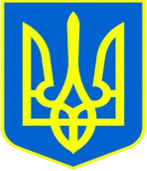 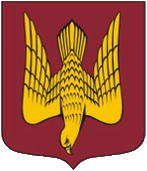
As we do not rely on images created by using a computer, since they are difficult to verify for authenticity, we attach a photo of a silver coin of Novgorod from the time of Yaroslav the Wise (XI century AD).  So, the “slaven“ (glory trident) could be seen throughout Rus' where the prince ruled under such a coat of arms. |  |
| Now that we have proven that the slaven (glory trident) is a princely symbol [1]~[2], we can move on to heraldry, the applied science of symbols and flags. So, many flags origin from coats of arms as simplification. | |
 |
According to the law of heraldry, the color of the coat of arms (embroidered with gilding) goes up, and the background (blue fabric) goes down. From here we get the yellow-blue flag as the simplification of Rurik dynasty coats of arms. |
| In eastern Rus', yellow-red color is also historically justified. In the picture on the right is the banner of Voronezh (Russian Federation). |  |
| Coats of arms of capital and historical cities of Ukraine | |
|---|---|
| The period of establishment of Soviet power in Ukraine is the most interesting from the view point of the heraldry history of Ukraine cities. At this time, the will of the urban population gained more freedom without the watchful eye of the ”big brother”. [3] | |
 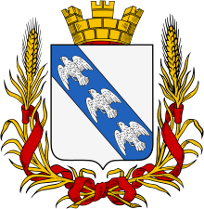
| In the picture on the left above is the historical coat of arms of Kursk in 1780. Below is the coat of arms of 1859 approved by the Russian royal authorities. [4]. Today, the historical coat of arms of Kursk in 1780 is more often depicted with white, not yellow falcons, like the imperial coat of arms of 1859. Which color is correct can be judged by the following image of 6 districts of the Kursk region at the end of the text (below). [4] The change in the color of the birds can be explained by the hatred of the Romanov dynasty for everything yellow and blue as a reminder of the Rurik dynasty . Click on the picture to see the coats of arms of all districts of the Kursk region [4] |
 | |
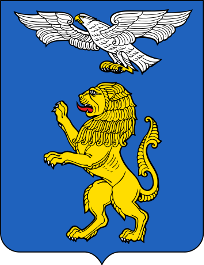 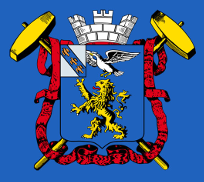 | After pressure from Moscow, the Ukrainian government was forced to give up the Bilhorod and Graivoronsky poviats (districts), and on February 7, 1919, the resolution of the National Council of the Ukrainian SSR ”On administrative management in the territory of the front line of Ukraine” was approved (published on February 11), which was the border of the Kharkiv province, and therefore, and the USSR, its pre-war borders were determined. [3] Another question about borders was raised in February 1929 at a meeting of Ukrainian writers with the General Secretary of the Central Committee of the All-Union Communist Party of Ukraine (b) Joseph Stalin, to which the answer was received: ”We in the Central Committee studied the issue twice and left it without consequences. We have to be especially careful, because such changes provoke huge opposition from some Russians”. [3] |
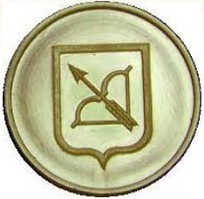  | The coat of arms of Kharkiv in the first period of its history as a regimental fortress city (1654-1765) is considered to be a black image of a drawn bow with an arrow on a gold cartouche field, mentioned in ”Chronogeographic Description of the City of Kharkiv” (1767) by Maksym Gorlenskyi's: ”The city of Kharkiv has long been the coat of arms is a stretched bow with an arrow” [5]. The modern coat of arms of Kharkov (bottom, left) is dated 1776 as the coat of arms of the Kharkov Hussar Regiment from the armorial of M. Shcherbatov. In 1781, it was approved by Catherine II as the coat of arms of the city of Kharkov [5]. |
 | |
  |
The city of Vyshhorod is first mentioned in the ”Tale of Timeless Years” around
946 AD as the estate (residence) of Princess Olga - ”Olzhyn Grad”. This is the
status of the ”capital city”, thanks to which Kyiv was founded. The coat of arms
of the city (pictured on the left) is connected with the ancient temples of this
city. Considerably interesting from the point of view of the history of heraldry of ancient cities of Rus’ and Ukraine is the flag of Vyshgorod. The Vyshhorod city flag is one of the first documented appearances of a red-black color, which was used by the Zaporozhian Cossacks and other warriors. |
 |
Kyiv has a coat of arms (Archangel Michael) which is mentioned and depicted in
ancient religious chronicles. In 1934, by decision of the People's Committee of the Ukrainian SSR, the capital of the republic was moved from Kharkiv to Kyiv. In the same year, under pressure from Moscow, Kuban switched from Ukrainian to Russian in business. 4 years before that, in large cities (Kursk, Voronezh, Bilhorod) which, under the pressure of Moscow, withdrew to the Russian Federation, the printing of Ukrainian-language newspapers and other periodicals was stopped (under the pressure of the same force). |
| The art depicts the coats of arms and flags of Rus’ in Ukraine | |
|---|---|
One of the most picturesque works where you can see the coats of arms and flags
of Rus’ in Ukraine is the painting ”Cossacks writing a letter to the Turkish
Sultan” from 1891. An enlarged part of the picture is shown below
(Click on for the full picture) .
 In a still from a documentary video from 2015, the banner of the Don Army is visible on an armored personnel carrier in the Donbass region. This is a very symbolic contradiction, since the soldiers raised a banner hostile to the country for which they are fighting. (Click on photo for full frame). 
| |
Coats of arms and flags of Rus’ in Ukraine are subject to distortion by turning the yellow-blue flag upside down. This distortion has already flooded art and the information network. The forces that did it are very influential. They ”washed out” all images of the yellow-blue flag from the information network. Fortunately, they forgot about black and white photos. | |
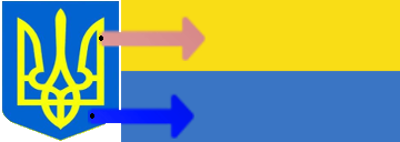 
|
To distinguish the order of placement of colors in a black-and-white photo,
it is enough to know the difference in brightness in black-and-white tones.
Above, on the left, we see it in color. Below, on the left, the upper picture has been converted to black and white. The yellow color becomes light gray (almost white), and the blue is simply gray. Now we are ready to check the order of color placement on old black and white photos by clicking on the black and white image (or here). |


Citations and references
| [1] | Source: | Bolsunovskij, K. V. Rodovoj — symbols of the Rurikids, great knyazes of Kiev (in Russian) 1907 (PDF) |
|---|---|---|
| * | Mirror: | Symbols of the Rurik dynasty, great princes of Kiev (in Russian) 1907 by K.Bolsunovskij PDF |
| [2] | Source: | Symbols of the Rurik dynasty and the falcon symbol. 1968, by Igor Babanov. (in Russian) Certificate of publication No. 218071000987. |
| * | Mirror: | Ancestral Coats of arms of the Rurik dynasty and the falcon symbol 1968, by Igor Babanov. (Russian) |
| [3] | Source: | Belgorod is the capital of Soviet Ukraine by Gennady Efimenko, 2017 “This day in history“ (Ukrainian) |
| * | Mirror: | Belgorod is the capital of Soviet Ukraine by Gennady Efimenko, 2017 (English) |
| [4] | Source: | The history of the symbols and anthem of the Kursk region. PDF (in Russian) |
| * | Mirror: | Coats of arms and flags of Rus’ in Ukraine - Soviet Kursk PDF (in Russian) |
| [5] | Source: | Coats of arms of the Kharkiv, 2006 Union of Heraldry of Russia (in Russian) |
| * | Mirror: | Coats of arms of the Kharkiv Region, 2006 (Russian) Union of Heraldry of Russia/TD> |
*Mirror: The mirror archive contains the same document as a source had at the publication time with a copyright attribues. Some documents may disappear from the Internet public access during the information war. It is why the most important documents are copied to the mirror archive. | ||